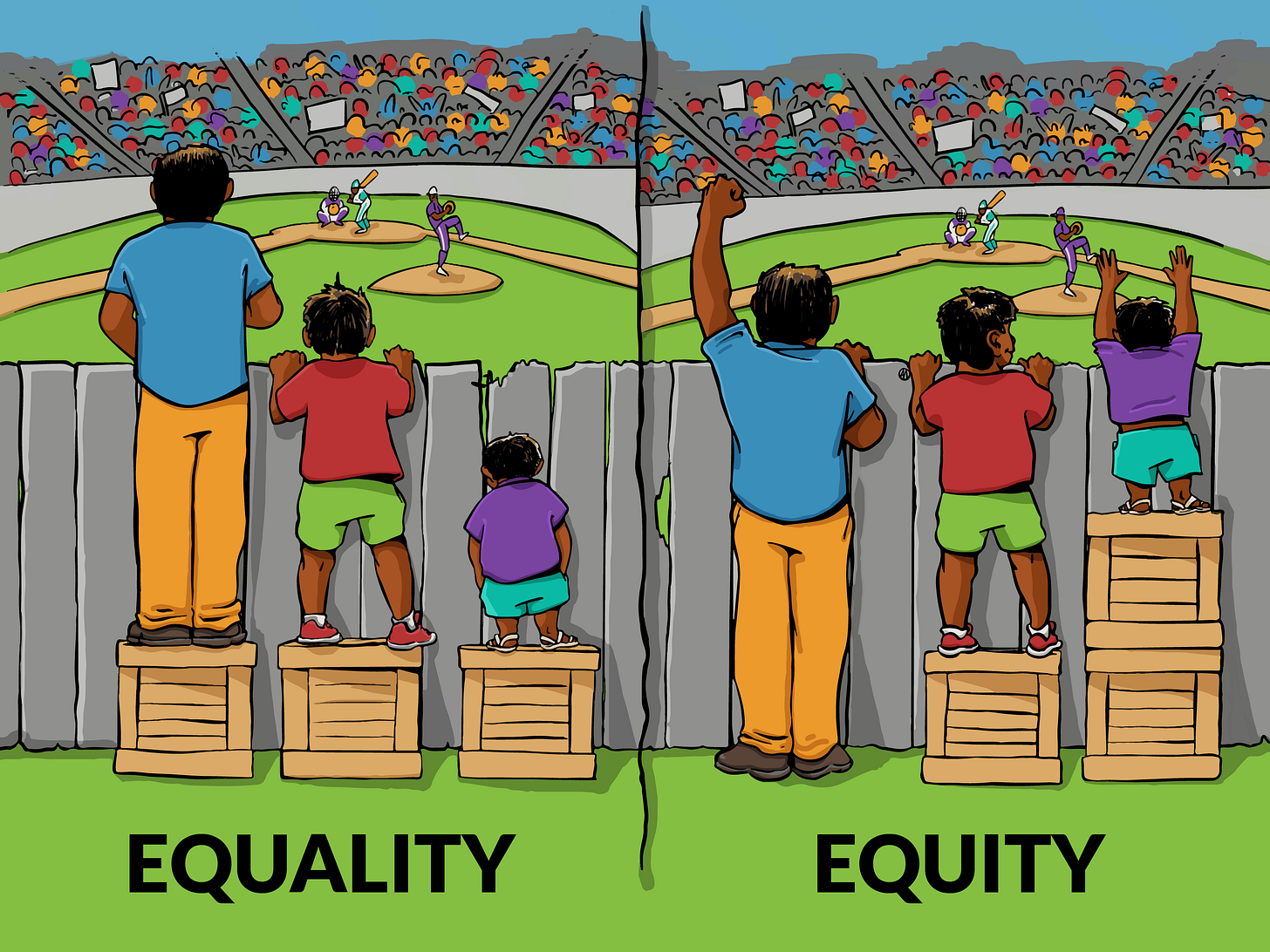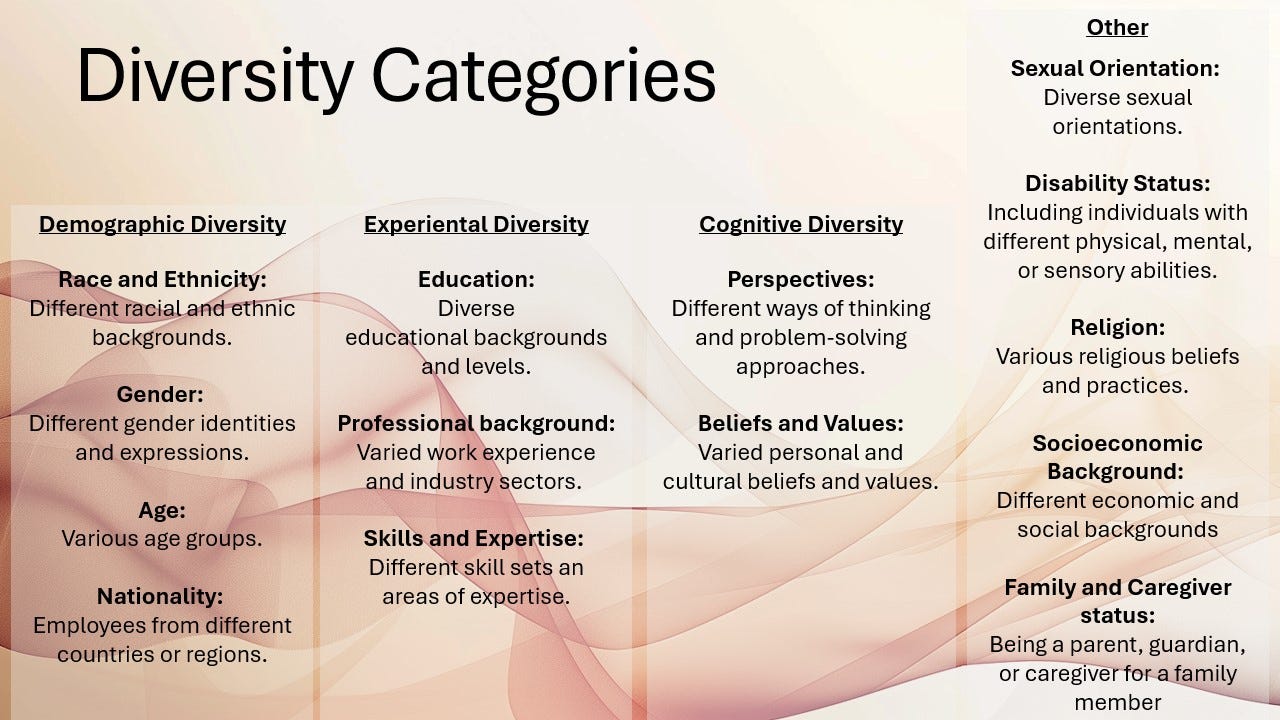DEI basics and why
Diversity, Equity, and Inclusion (DEI) is a framework aimed at fostering an inclusive work environment that values and respects the unique qualities and perspectives of every individual employee.
Diversity, Equity, and Inclusion (DEI) are crucial components for any thriving organization. They not only ensure a fair and respectful workplace but also drive innovation and success. Diversity refers to the representation of different identities, backgrounds, and perspectives, encompassing race, gender, age, ethnicity, sexual orientation, disability, and socioeconomic status. Equity involves creating fair opportunities and addressing systemic imbalances, recognizing that different people have different needs. Inclusion is about fostering an environment where all employees feel valued, respected, and supported. By understanding and implementing DEI, organizations can harness the full potential of their workforce, leading to enhanced creativity, improved decision-making, and a stronger, more inclusive culture. Let’s delve deeper into each component to see how DEI can transform your organization.
The three components of DEI
Diversity refers to the representation of different identities, backgrounds, and perspectives within a company. This includes, but is not limited to, differences in race, gender, age, ethnicity, sexual orientation, disability, and socioeconomic status.
Equity involves creating fair opportunities and removing barriers to ensure that all individuals have access to the same opportunities. Equity recognizes that different people have different needs and addresses systemic imbalances.
Inclusion is about creating an environment where all employees feel valued, respected, and supported. Inclusive workplaces encourage participation and contribution from everyone, ensuring that diverse voices are heard and integrated into decision-making processes.
Let’s go through each component individually to get a better understanding of the concept and idea behind DEI.
Diversity
Diversity is the presence of differences within a given setting, encompassing a wide range of characteristics that make individuals unique. In the workplace, diversity is crucial for fostering an inclusive and dynamic environment where all employees can thrive. Diversity can be categorized into several dimensions:
Demographic Diversity: This includes visible and measurable characteristics such as race and ethnicity, gender, age, and nationality. These aspects are often the first layer of diversity that organizations focus on to ensure representation and inclusivity.
Experiential Diversity: This dimension covers the various life experiences that shape an individual’s perspectives and skills. It includes educational backgrounds, professional experiences, and specific skill sets. Recognizing experiential diversity helps organizations value the unique contributions each employee can make based on their personal journey.
Cognitive Diversity: Cognitive diversity refers to differences in thought processes, problem-solving approaches, and perspectives. It involves appreciating varied beliefs and values, and understanding that these differences can drive innovation and creative solutions within teams.
Other Dimensions: Beyond demographic, experiential, and cognitive categories, there are other critical aspects of diversity such as sexual orientation, disability status, religion, socioeconomic background, and family or caregiver status. These dimensions address the deeper layers of diversity, ensuring that all forms of human identity and experience are recognized and respected.
By embracing these diverse dimensions, organizations can create a more equitable and inclusive environment that leverages the full potential of all employees.
Equity
The E in DEI is Equity. It is commonly accepted that equity and equality is for the good of us all. But what is really the difference between Equity and Equality? Wouldn’t it be better to go for Equality?
Equality is the principle of providing the same resources or opportunities to all individuals, regardless of their background, needs, or circumstances. The goal is to ensure that everyone receives the same treatment and access to resources.
Equity, on the other hand, recognizes that individuals have different circumstances and allocates resources and opportunities in a way that addresses those differences. The aim is to achieve fair outcomes by taking into account the diverse needs and challenges of individuals.
Below figure perfectly illustrates the difference. It is clear the equity is the one that enable all to participate on equal terms. Equity is an enabler of a fair system and a prerequisite for a diverse set of competencies and views to come into play in an organization.

Inclusion
Inclusion is the practice of creating a work environment where all individuals feel valued, respected, and supported, allowing them to fully participate and contribute to the organization. In a diverse workforce, inclusion is essential for harnessing the benefits of diversity. It involves more than just representation; it requires actively involving diverse perspectives in decision-making processes and fostering a culture of belonging.
Inclusion supports a diverse organization by ensuring that differences are not just acknowledged but embraced and integrated into everyday practices. This means developing policies that address the unique needs of various employee groups, offering equitable opportunities for career advancement, and creating safe spaces where everyone can voice their ideas and concerns without fear of discrimination or bias.
An inclusive workplace cultivates higher employee engagement and satisfaction, as individuals who feel included are more likely to be committed and motivated. This leads to better collaboration, as diverse teams are encouraged to bring their whole selves to work, contributing a rich array of ideas and solutions.
Furthermore, inclusion drives innovation and creativity. When diverse perspectives are genuinely considered, organizations are better equipped to tackle complex problems and adapt to changing market demands.
In essence, inclusion is the key to unlocking the full potential of a diverse workforce. It ensures that every employee, regardless of their background, has the opportunity to thrive, leading to a more dynamic, innovative, and successful organization.
Why DEI?
In general we need diversity to ensure a varied and broad range of competencies which is an enabler of creativity and innovation. We need the Equity to ensure a fair and just environment that foster wellbeing and psychological safety. Finally we need the inclusion to glue it all together and support employee relations and retention. Inclusion is also the part that practices the psychological safety and facilitates that diverse views and ideas will emerge.
In future posts I will look into how DEI supports some of the following stated benefits and suggest actionable ways for you to succeed in DEI.
Enhanced Creativity and Innovation
Improved Employee Engagement and Retention
Better Decision-Making
Attracting Top Talent
Reputation and Brand Image
Legal and Compliance Benefits
Global Competence


